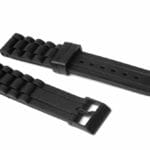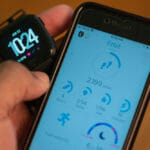Wearing a watch is not only a practical way to keep track of time but also a fashion statement that reflects your personal style. However, many people wonder which wrist they should wear their watch on, especially with various beliefs and traditions associated with this choice.

In this article, we’ll explore what side you should wear your watch on and delve into the factors that influence this decision.
The primary factor in determining which wrist to wear your watch on is your dominant hand. As a general rule, it’s recommended to wear your watch on the opposite wrist of your dominant hand. For example, if you’re right-handed, you should typically wear your watch on your left wrist.
This is because your dominant hand is more coordinated and has better fine motor skills, which can help prevent your watch from getting bumped or scratched during daily activities.
Additionally, wearing your watch on your non-dominant hand can make it more comfortable and easier to check the time without interfering with your dominant hand’s tasks.
Key Points
- Wearing a watch on the opposite wrist of your dominant hand is generally recommended
- This choice allows for greater comfort and prevents the watch from getting bumped or scratched
- Considerations like watch fit and personal style can also influence the wrist you choose to wear your watch on
The Basics of Wearing a Watch
Wearing a watch might seem straightforward, but there are some guidelines to help you make the most of your timepiece. To begin with, you should wear your watch on the opposite wrist of your dominant hand. This makes it more comfortable and ensures it’s less likely to get in the way during daily activities.
For instance, if you’re right-handed, wear your watch on your left wrist. This will make it easier for you to check the time while allowing your right hand to stay free for other tasks. On the other hand, if you’re left-handed, switching the watch to your right wrist is ideal.
Watches come in various materials, like aluminum, stainless steel, and titanium. Knowing the difference between these materials can help you choose the best option based on your lifestyle and preferences.
Today’s smartwatches offer numerous features, including heart rate monitoring, sleep tracking, and even blood pressure measurements. Keep in mind that not all smartwatches are created equal, so research the features available on different models to find the one that suits your needs.
Remember to keep your watch clean and well-maintained. Regularly wiping the watch face and band with a soft cloth will ensure it looks great and functions properly. Also, be mindful of water resistance ratings, as some watches can withstand a splash while others can be fully submerged.
Watches and Dominant Hands
Hey, did you know that the dominant hand plays a big role in deciding which wrist you should wear your watch on? Let’s check out how this works for right-handed, left-handed, and ambidextrous individuals!
Right-Handed Individuals
If you’re right-handed, you’re in the majority! Over 90% of people are right-handed, and they usually wear their watches on their left wrist. This makes sense because your dominant hand is better at performing tasks, like writing or using tools. So, by wearing your watch on the non-dominant hand, you can avoid bumping it or getting it caught while doing daily activities. Plus, it’s easier to wind or adjust the watch with your dominant hand!
Left-Handed Individuals
Now, if you’re left-handed, you might think that you should also wear your watch on the non-dominant hand. That’s correct! Most left-handed people wear their watches on their right wrist. Following the same logic as right-handed individuals, wearing your watch on the non-dominant hand helps you avoid damaging it and makes it simpler to adjust the time or date when needed. And don’t worry, there are also many watches specially designed for left-handed users!
Ambidextrous Individuals
If you’re ambidextrous, that’s amazing! It means you can use both of your hands with equal skill. In this case, you might be wondering which wrist is best for your watch. Well, you have the freedom to choose since both hands are capable of performing tasks equally well. You could even switch between wrists if you like. Just find what feels the most comfortable and convenient for you, and enjoy your watch-wearing experience!
Finding the Perfect Watch Fit
Watch Band Materials
Selecting the right watch band material is crucial for achieving a comfortable fit. There are plenty of materials to choose from, such as metals, leather, or synthetic materials. When choosing a band, think about how it will feel against your skin and how it might react to different weather and moisture conditions. For example, a Apple Watch might have different strap options available for those with smaller wrists.
Comfort Measurements
To ensure your watch is a perfect fit, it’s essential to consider its size and how it sits around your wrist. Start by measuring your wrist to help determine the ideal watch case diameter. For instance, men’s watches tend to have larger case diameters compared to women’s watches. There is a noticeable difference between sizes, such as with the Apple Watch Series 3 (38mm) and (42mm).
Next, focus on the watch band itself. Your watch should not slide more than an inch up or down your arm when you move. A quick way to assess the fit is by sliding a finger between the band and your wrist. A well-fitting watch will allow one finger to slide in, while a loose one might let two fingers fit comfortably.
Correct Positioning
Putting your watch in the correct position on your arm is just as important as choosing the right materials and measurements. Typically, a watch should be worn just above the wrist bone on your non-dominant arm, allowing for easy access and minimal interference with daily tasks. You can also adjust the watch face, whether it’s analog or digital, to ensure the time is visible without disrupting your comfort.
Remember, finding the perfect watch fit might take some trial and error, so don’t be afraid to experiment with different materials, styles, and positions until you find what works best for you. So, go ahead and confidently choose a watch that not only looks great but feels comfortable on your wrist.
Left-Handed Watches
Unique Features
Hey there! Get ready to learn about left-handed watches and the unique features that make them special. Left-handed watches are designed specifically for people who wear their watches on the right wrist. They have a watch crown located on the left side of the watch case. This feature makes it easier for you to adjust the time and date without reaching over the watch face.
Additionally, these watches often have reversed dials, with the numbers placed counterclockwise. This might look a bit unusual at first, but it’s perfect for lefties who want a watch that’s tailored to their needs.
Choosing the Right One
Picking the perfect left-handed watch can be exciting! When choosing the right one, consider your personal style and preferences. There are many fantastic options available, ranging from classic designs with leather straps to modern digital watches with lots of cool features.
Remember to pay attention to the watch crown’s placement, as it should be on the left side of the case for true left-handed watches. And don’t forget to check if the watch dial is reversed, as this unique touch will make your watch even more special.
Wearing a Watch Upside Down
Have you ever wondered why some people wear their watches upside down? It might seem unusual, but there are a few reasons for this practice. First of all, wearing a watch upside down could make it easier for you to tell the time. With the watch face on the inside of your wrist, you can quickly glance at it without moving your arm much.
Another reason for wearing a watch upside down is that it might protect your watch from damage. Your wrist is likely to bump into things throughout the day, so having the watch face on the inside can help keep it safe from scratches and other forms of damage.
What about glowing watches, you ask? Well, there are ways to make your watch glow better, and wearing it upside down might be one of them! By positioning the watch face closer to your body, you’re keeping it away from sunlight and other sources of light, which can affect the intensity of the watch’s glow.
Smartwatches and Double Wrists
So, you’re interested in wearing a smartwatch and a traditional watch on both wrists? That’s an exciting idea! With a smartwatch on one wrist, you get the benefits of messaging, phone calls, and countless apps that keep you connected. On the other wrist, a mechanical or traditional watch is perfect for style and elegance.
In today’s world, smartwatches like the Apple Watch and Samsung Galaxy Watch are making things more interesting. These devices are not only functional, but they can also be a fashion statement. The best part? You can wear your favorite watches on both wrists!
But which wrist should you wear each watch on? Well, that depends on your personal preference and which hand you use the most. Most people use the left hand for wearing a traditional watch, so you might want to wear your smartwatch on the right wrist. However, if you are left-handed and would rather wear your smartwatch on your left wrist, go for it! There are no strict rules about this, so choose whatever feels comfortable for you.
Smartwatches are becoming increasingly popular, and many people are starting to wear them together with traditional watches. This trendy combination is perfect for those who appreciate both cutting-edge technology and classic timepieces. Whether you are pairing your smartwatch with an LG phone or a Samsung S8, your stylish combination will definitely turn heads.
Practical Considerations
Wearing a watch is more than just a style choice – there are practical aspects to consider too! Let’s dive into some essential factors that’ll help you decide the best way to wear your watch.
First things first, think about your watch’s movements. For most people, it’s more comfortable to wear a watch on their non-dominant wrist. Why? Well, this helps keep your watch secure while you’re going about your daily tasks. Plus, it doesn’t get in the way when you’re writing or doing other important activities with your dominant hand.
Now, let’s talk about practicality. Since most watches have the crown on the right side of the case, it’s easier to adjust the time if you wear it on your left wrist. That way, you can quickly change the time without having to take your watch off. Pretty neat, huh?
When it comes to finding the perfect fit for your watch, you might need to remove some links to make it snug but comfortable on your wrist. Don’t worry about this process – it’s easy to do, and it’ll make a huge difference in how your watch feels while you’re wearing it.
One more thing: watch out for your wrist bone! When you wear a watch, you don’t want it to rest directly on your wrist bone. So make sure you position your watch just above or below your wrist bone for a more comfortable fit.
The Psychology of Watch Wearing
You might find it fascinating to learn that the side you choose to wear your watch can reveal something about your personality and psychology. Your personal preference for wearing a watch on the left or right side can be influenced by various factors like practicality, comfort, and even the type of watch you own.
For example, if you’re considering fitness trackers, you might want to compare an Apple Watch with a Whoop. Understanding the differences in features and style could help you decide what type of watch suits you best.
Wearing a watch on your non-dominant hand is a practical choice for most people. This way, you can perform tasks with your dominant hand without the watch getting in the way. It’s a logical decision that many people naturally make without even thinking about it.
Some people, on the other hand, might choose to wear their watch on the right side due to comfort or simply because it’s their personal preference. This preference could be influenced by a watch’s design, weight, or band material.
Your choice of watch can also say something about your personality. Comparing devices like the Whoop and the Garmin can give you a sense of which features you value most. For instance, if you focus on fashion and status, you might be drawn to luxury watches. On the other hand, if you prioritize function and practicality, a smartwatch or fitness tracker might be more your style.
Types of Watches and Bracelet Materials
Dress Watches
Dress watches are perfect for formal occasions or business settings. These watches typically have a metal bracelet or a leather strap and are designed to be classy and sophisticated. You can wear your dress watch to a wedding, a fancy dinner, or even during an important business meeting. The slim design and elegant materials make dress watches a must-have addition to your wardrobe.
Metal Bracelet Watches
These types of watches come with a metal bracelet strap, available in various materials like stainless steel or gold. Metal bracelet watches are incredibly versatile, suitable for casual, semi-formal, or even formal attire. Not just style but also durability makes metal bracelets popular, as they can stand up to daily wear and tear. A properly-maintained metal bracelet watch can last for years, making it an excellent investment in your timepiece collection.
Water-Resistant Watches
Water-resistant watches are specially designed for those who love water-based activities, such as swimming, diving, or simply getting caught in the rain. These watches can withstand water pressure, and some can even function at various depths underwater. Water-resistant watches often come with either a durable rubber strap or a corrosion-resistant metal bracelet. If you plan on doing any water-based activities, a water-resistant watch may be the perfect fit for you.






